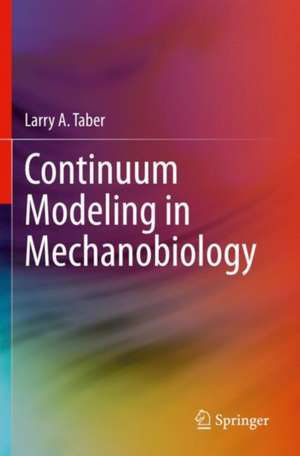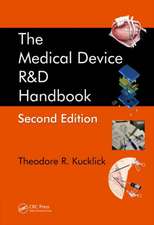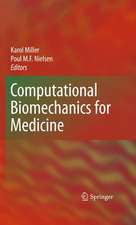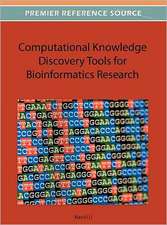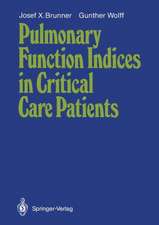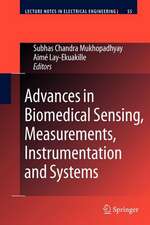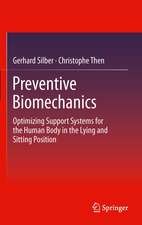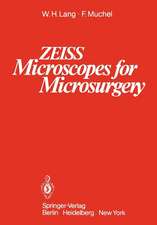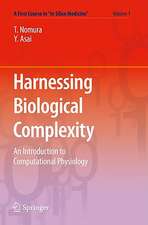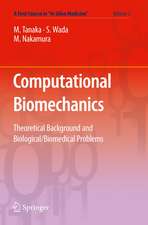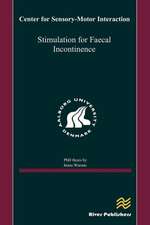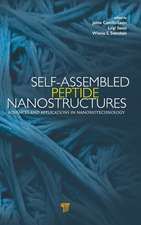Continuum Modeling in Mechanobiology
Autor Larry A. Taberen Limba Engleză Paperback – 16 iun 2021
| Toate formatele și edițiile | Preț | Express |
|---|---|---|
| Paperback (1) | 752.72 lei 38-44 zile | |
| Springer International Publishing – 16 iun 2021 | 752.72 lei 38-44 zile | |
| Hardback (1) | 1005.92 lei 38-44 zile | |
| Springer International Publishing – 16 iun 2020 | 1005.92 lei 38-44 zile |
Preț: 752.72 lei
Preț vechi: 792.34 lei
-5% Nou
Puncte Express: 1129
Preț estimativ în valută:
144.08€ • 156.55$ • 121.10£
144.08€ • 156.55$ • 121.10£
Carte tipărită la comandă
Livrare economică 17-23 aprilie
Preluare comenzi: 021 569.72.76
Specificații
ISBN-13: 9783030442958
ISBN-10: 3030442950
Pagini: 535
Ilustrații: XVII, 535 p. 310 illus., 196 illus. in color.
Dimensiuni: 155 x 235 mm
Greutate: 0.99 kg
Ediția:1st ed. 2020
Editura: Springer International Publishing
Colecția Springer
Locul publicării:Cham, Switzerland
ISBN-10: 3030442950
Pagini: 535
Ilustrații: XVII, 535 p. 310 illus., 196 illus. in color.
Dimensiuni: 155 x 235 mm
Greutate: 0.99 kg
Ediția:1st ed. 2020
Editura: Springer International Publishing
Colecția Springer
Locul publicării:Cham, Switzerland
Cuprins
Introduction.- Vectors and tensors.- Coordinate transformation.- Tensor invariants.- Special tensors.- Vector and tensor calculus.- Nonlinear Elasticity.- Kinematics.- Stress.- Balance principles.- Constitutive equations.- Boundary value problems.- Active Force Generation.- Muscle contraction.- Concept of changing zero-stress state.- Cardiac mechanics: time-varying elastance.- Stress fibers.- Cell division.- Growth.- Growth theory.- Growth of arteries.- Growth of the heart.- Growth of tumors.- Growth of plants.- Remodeling.- Remodeling theory.- Remodeling of arteries.- Aneurysms.- Cytoskeletal remodeling.- Bone remodeling (Wolff’s law).- Morphogenesis.- Fundamental developmental processes.- Modeling morphogenesis.- Pattern formation.- Gastrulation.- Head fold formation.- Neurulation.- Brain development.- Primary vesicle formation.- Cortical folding.- Eye development.- Heart development.- Cardiac looping.- Gut development.- Wound healing.- Plant morphogenesis.- Mechanical feedback in development.
Notă biografică
Larry Taber is a Senior Professor of Biomedical Engineering at Washington University in St. Louis. From 2007 until his retirement in 2017, he was the Dennis and Barbara Kessler Professor of Biomedical Engineering. Although his formal training is in aerospace engineering (B.A.E., Georgia Tech; Ph.D., Stanford University), he has published on a wide range of topics including cochlear mechanics, nonlinear shell theory, cardiovascular mechanics, and the mechanics of growth and development. Dr. Taber is a fellow of the American Society of Mechanical Engineers (ASME) and the American Institute for Medical and Biological Engineering. Three times he won the Richard Skalak Award for the best paper published in the Journal of Biomechanical Engineering, and in 2020 was awarded the H.R. LIssner Medal from ASME. From 2011-2016, he served as co-editor-in-chief of the journal Biomechanics and Modeling in Mechanobiology.
Textul de pe ultima copertă
This book examines key theoretical tools that are currently used to develop mathematical models as an aid in understanding the biological response of cells and tissues to mechanical stimuli. Problems in growth and remodeling, tissue and organ development, and functional adaptation are all covered. Chapters on tensor analysis and nonlinear elasticity provide the necessary background for understanding the engineering theories that are currently used to solve challenges in mechanobiology. This is an ideal book for biomechanical engineers who work on problems in mechanobiology and tissue engineering.
- Broadens readers’ understanding of nonlinear elasticity, contractility, growth and remodeling theory, and mechanical feedback in development
- Includes numerous quantitative examples to illustrate basic theoretical mechanobiology concepts, such as active force generation, theories for growth and remodeling, and morphogenesis
- Illustrates theories with numerous applications to specific problems, such as cardiac mechanics, growth (and remodeling) of the heart and arteries, and embryonic development of the heart, brain, and gut
Caracteristici
Broadens readers’ understanding of nonlinear elasticity, contractility, growth and remodeling theory, and mechanical feedback in development
Includes numerous quantitative examples to illustrate basic theoretical mechanobiology concepts, such as active force generation, theories for growth and remodeling, and morphogenesis
Illustrates theories with numerous applications to specific problems, such as cardiac mechanics, growth (and remodeling) of the heart and arteries, and embryonic development of the heart, brain, and gut
Includes numerous quantitative examples to illustrate basic theoretical mechanobiology concepts, such as active force generation, theories for growth and remodeling, and morphogenesis
Illustrates theories with numerous applications to specific problems, such as cardiac mechanics, growth (and remodeling) of the heart and arteries, and embryonic development of the heart, brain, and gut
